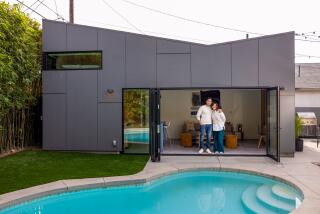Living Rooms Are Giving Way to Areas That Let Folks Live
- Share via
The living room is dying.
Long a model of stuffy grace and fancy furniture, the traditional living room--employed rarely and off-limits to children and pets--has all but disappeared from American homes.
Its replacement? A zone that gets daily use in the form of Internet browsing, television watching, eating, drinking, exercising or conducting business.
Living rooms also have become physically less distinct since homeowners have begun knocking down walls separating kitchens from dining areas and dens from living rooms.
“I find that clients like this open flow of space. It’s all just coalescing, one room into another,” said Hilary Imes, an interior designer in San Clemente.
Decorators say the technology-saturated 1990s have made media rooms the current darling, with people packing in computers, stereos, big-screen televisions, CD players, home satellite systems and video games.
“The younger generation wants to buy all those electronic gadgets and you need a space to put them in. The living room goes away,” said Atlanta interior designer Hugh James, who has seen the less-than-subtle shift away from living rooms over the last decade.
Bill and Tricia McCutchen got rid of their living room in their last move, their third in 18 years. The couple instead hang out in a sunroom that adjoins their large kitchen in Roswell, an Atlanta suburb.
“We did away with it because we never used it,” Tricia McCutchen said. And with the couple’s children out of the house, the two “kind of live in the kitchen,” she said.
“It all boils down to lifestyles,” she said. “People just don’t entertain formally any more--don’t have time.”
The traditional living room has morphed into entertainment centers, libraries, home offices, exercise areas and private space for older people who have moved in with their children.
“Most of the time I find that people who request a formal living room are using it for a piano,” said John Slappey, a real estate agent in Buford who plans to install a pool table in his living room. “I’ve got a formal living room and it’s got furniture in there that’s just collecting dust.”
Living rooms once were the domain of people engaged in more structured, less manic lifestyles, where guests were entertained formally, books were read and drinks were sipped by a fireplace. Such a space doesn’t accommodate the way people live anymore, said Ann Platz, an Atlanta interior designer.
“We live in a fast-paced world, and we drive into McDonald’s. It’s kind of instant living,” she said.
The change also has been spurred by the way people entertain. “People are not doing high tea anymore,” said Dan Bawden, president of the Greater Houston Builders Assn.
Today’s dinner parties are more likely to involve casually dressed company having cocktails and grazing in the kitchen than dressed-to-the-nines guests sipping martinis in a living room before sitting down for dinner, Platz said.
The living room’s transformation has been accompanied by bigger homes over the last 20 years. The average single-family home has increased from 1,645 square feet in 1975 to 2,190 square feet last year, according to the National Assn. of Home Builders.
That jump also has led to huge differences in the amount of space people want in particular rooms, builders report.
Walk-in closets are in, as are large bedroom suites, behemoth bathrooms and kitchens with big food-preparation islands. The breakfast nook has expanded exponentially.
Those desires lead to cuts elsewhere. The living room is usually first to go.
“They give you their wish list and very seldom does it include a dedicated living room with living room furniture,” said Paul Davidson, president of Davidson/Kopp Group, a Georgia company that builds $300,000-plus homes. “You just don’t hear people say they want a living room anymore.”
Still, old habits die hard: About 89% of new homes are built with a living room, even though most aren’t used as the formal spaces builders designate, said Andrew Kochera, an economist with the home builders association in Washington.
“In the majority of the houses in America, eventually that living room is going to go away and become a library-slash-office,” predicts Ron Becker, president-elect of the International Furnishings and Design Assn.
More to Read
Inside the business of entertainment
The Wide Shot brings you news, analysis and insights on everything from streaming wars to production — and what it all means for the future.
You may occasionally receive promotional content from the Los Angeles Times.










